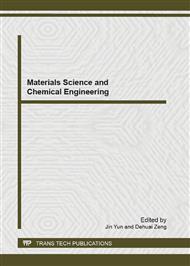[1]
C. H. Johnson, P. L. Stewart, and M. Egli, The Cyanobacterial Circadian System: From Biophysics to Bioevolution, Annu. Rev. Biophys., vol. 40, no. 1, p.143–167, Jun. 2011.
DOI: 10.1146/annurev-biophys-042910-155317
Google Scholar
[2]
M. Ishiura, Expression of a Gene Cluster kaiABC as a Circadian Feedback Process in Cyanobacteria, Science, vol. 281, no. 5382, p.1519–1523, Sep. 1998.
DOI: 10.1126/science.281.5382.1519
Google Scholar
[3]
T. Kondo, C. A. Strayer, R. D. Kulkarni, W. Taylor, M. Ishiura, S. S. Golden, and C. H. Johnson, Circadian rhythms in prokaryotes: luciferase as a reporter of circadian gene expression in cyanobacteria., Proc. Natl. Acad. Sci. U.S.A., vol. 90, no. 12, p.5672–5676, Jun. 1993.
DOI: 10.1073/pnas.90.12.5672
Google Scholar
[4]
M. NAKAJIMA, Reconstitution of Circadian Oscillation of Cyanobacterial KaiC Phosphorylation in Vitro, Science, vol. 308, no. 5720, p.414–415, Apr. 2005.
DOI: 10.1126/science.1108451
Google Scholar
[5]
H. KAGEYAMA, Circadian Formation of Clock Protein Complexes by KaiA, KaiB, KaiC, and SasA in Cyanobacteria, Journal of Biological Chemistry, vol. 278, no. 4, p.2388–2395, Nov. 2002.
DOI: 10.1074/jbc.m208899200
Google Scholar
[6]
Y. Taniguchi, A. Yamaguchi, A. Hijikata, H. Iwasaki, K. Kamagata, M. Ishiura, M. Go, and T. Kondo, Two KaiA-binding domains of cyanobacterial circadian clock protein KaiC., FEBS Letters, vol. 496, no. 2, p.86–90, May 2001.
DOI: 10.1016/s0014-5793(01)02408-5
Google Scholar
[7]
Y. Kitayama, H. Iwasaki, T. Nishiwaki, and T. Kondo, KaiB functions as an attenuator of KaiC phosphorylation in the cyanobacterial circadian clock system., The EMBO Journal, vol. 22, no. 9, p.2127–2134, May 2003.
DOI: 10.1093/emboj/cdg212
Google Scholar
[8]
S. B. Williams, I. Vakonakis, S. S. Golden, and A. C. LiWang, Structure and function from the circadian clock protein KaiA of Synechococcus elongatus: a potential clock input mechanism, Proc. Natl. Acad. Sci. U.S.A., vol. 99, no. 24, p.15357, 2002.
DOI: 10.1073/pnas.232517099
Google Scholar
[9]
X. Qin, M. Byrne, T. Mori, P. Zou, D. R. Williams, H. Mchaourab, and C. H. Johnson, Intermolecular associations determine the dynamics of the circadian KaiABC oscillator, Proc. Natl. Acad. Sci. U.S.A., vol. 107, no. 33, p.14805–14810, 2010.
DOI: 10.1073/pnas.1002119107
Google Scholar
[10]
H. KAGEYAMA, T. Nishiwaki, M. NAKAJIMA, H. Iwasaki, T. Oyama, and T. Kondo, Cyanobacterial Circadian Pacemaker: Kai Protein Complex Dynamics in the KaiC Phosphorylation Cycle In Vitro, Molecular Cell, vol. 23, no. 2, p.161–171, Jul. 2006.
DOI: 10.1016/j.molcel.2006.05.039
Google Scholar
[11]
R. Pattanayek, D. R. Williams, S. Pattanayek, T. Mori, C. H. Johnson, P. L. Stewart, and M. Egli, Structural model of the circadian clock KaiB–KaiC complex and mechanism for modulation of KaiC phosphorylation, The EMBO Journal, vol. 27, no. 12, p.1767–1778, May 2008.
DOI: 10.1038/emboj.2008.104
Google Scholar
[12]
J. D. Thompson, D. G. Higgins, and T. J. Gibson, CLUSTAL W: improving the sensitivity of progressive multiple sequence alignment through sequence weighting, position-specific gap penalties and weight matrix …, Nucleic Acids Research, 1994.
DOI: 10.1093/nar/22.22.4673
Google Scholar
[13]
K. Tamura, D. Peterson, N. Peterson, and G. Stecher, MEGA5: molecular evolutionary genetics analysis using maximum likelihood, evolutionary distance, and maximum parsimony methods, Molecular biology and …, 2011.
DOI: 10.1093/molbev/msr121
Google Scholar
[14]
V. Dvornyk, O. Vinogradova, and E. Nevo, Origin and evolution of circadian clock genes in prokaryotes., Proc. Natl. Acad. Sci. U.S.A., vol. 100, no. 5, p.2495–2500, Mar. (2003)
DOI: 10.1073/pnas.0130099100
Google Scholar


